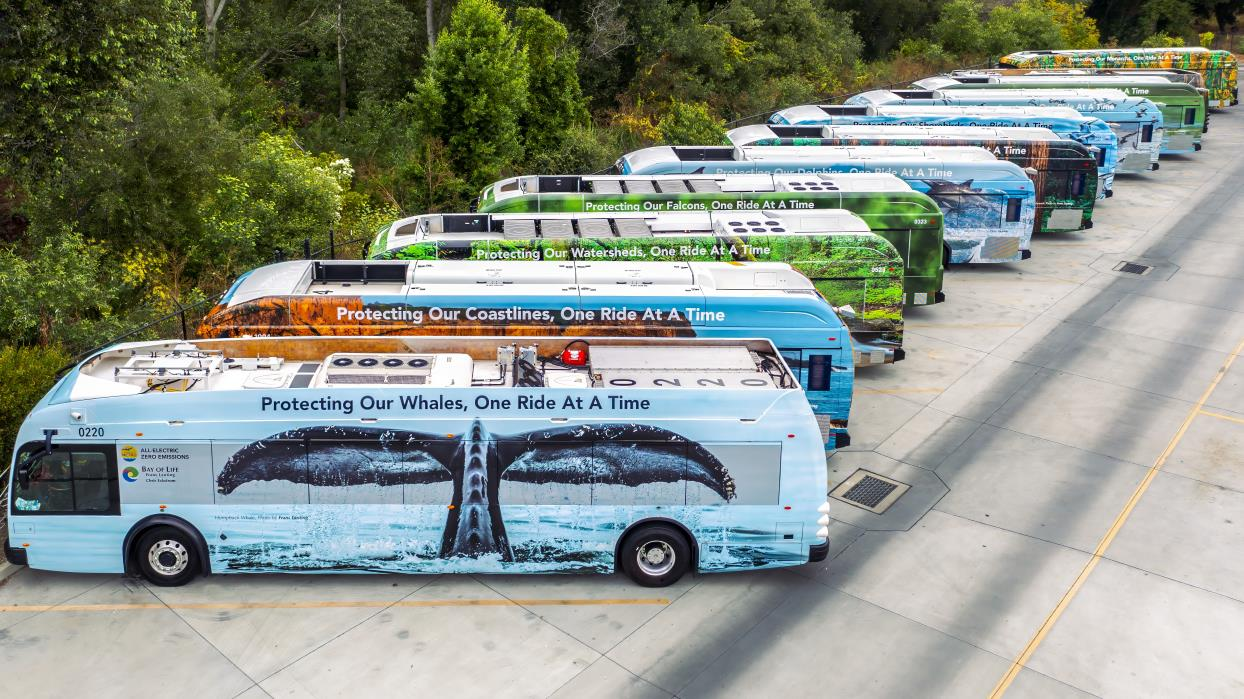Santa Cruz METRO Rolls Out New ‘One Ride at a Time’ Wildlife Buses in 2024 
With the start of the New Year, Santa Cruz Metropolitan Transit District (METRO) has unveiled more wildlife buses as part of One Ride at a Time, its acclaimed campaign to showcase the environmental benefits of transit, encourage bus ridership, and protect Santa Cruz County’s extraordinary natural resources. The new buses join the 22 photowrapped buses already carrying passengers throughout the region.
With this new wave of vehicles, METRO also welcomes a new partner to the One Ride at a Time campaign: Kevin Lohman, an award-winning photographer whose images of birds have been recognized by the National Audubon Society. Lohman’s image of a great horned owl fledgling graces one of the buses.
“I am thrilled to join the dedicated team of photographers and environmental advocates behind METRO’s One Ride at a Time campaign,” Lohman said. “In its first year, the campaign has already done so much to raise awareness and funds for conservation in Santa Cruz County. I can’t wait to see the strides we will make together in 2024.” Through One Ride at a Time, every ride on a METRO bus donates to METRO’s partners in protecting the environment, the Monterey Bay National Marine Sanctuary Foundation and the Bay of Life Fund.
BART Rider Satisfaction and Police Presence Gain in New Survey
Customer satisfaction with BART is rising as overall ridership increased by more than 9% over last year and a greater percentage of those riders than ever say they are seeing BART PD on their trips. The trends are included in BART’s latest Quarterly Performance Report covering October-December 2023.
BART’s overall customer satisfaction rating in the most recent Passenger Experience Survey (PES) reached 81%, which is up 7% from the previous quarter. This is the third consecutive quarter PES results have shown that BART’s overall customer satisfaction rating has increased. PES is a year-round survey conducted on BART trains on a near-daily basis.
It is the first time since the 2012 Customer Satisfaction Survey that BART has seen a Customer Satisfaction rate in the 80s. Overall satisfaction hovered between 84 and 86 percent from 2004 through 2012, before hitting a low of 56% in 2018. In our latest survey in 2022, satisfaction was 67%. BART conducts the Customer Satisfaction survey every other year and the next survey will be fielded in Fall of 2024.
This improvement in ratings comes as BART has advanced the implementation of its Safe and Clean Plan which focuses on boosting the visible safety presence in the system and increasing staffing to clean trains and stations.
For the second consecutive quarter the percentage of riders who say they have seen BART PD on their trip has reached a record high. This time 20.3% of those questioned reported they saw BART’s safety presence on trains or in stations. That’s up from the previous record of 17% just last quarter. The last two quarters have been the first in BART’s history where the percentage of riders who reported seeing BART PD exceeded the agency’s official goal of 12%.
BART’s efforts to be at the forefront of combating sexual harassment and gender-based violence continue to show results. The percentage of riders saying they have experienced sexual harassment on BART has been declining since early 2023. In the latest quarter the percentage fell to 7%, which is down from a high of 10%. The improvement follows the launch of Phase II of the Not One More Girl campaign.

Welcoming Thomas Utrup as Voith Turbo Western Regional Sales Manager
Association business member, Voith Turbo, recently welcomed Thomas Utrup as Western Regional Sales Manager to the Voith NA Sales team. In his new role, Tom will be supporting Voith Turbo North America within the Western Region, including California, Oregon, Washington, Arizona, Nevada, Utah, Colorado, New Mexico, Idaho, Wyoming, Montana, Hawaii, Alaska, and parts of the Dakotas. Tom is based out of his home office in Murrieta, CA and reports directly to Daniel Hollenbach, Senior Sales Manager for all of Western North America.
Tom has an extensive background in sales and sales management within the public transportation sector, working for firms that include Complete Coach Works, Daimler-Orion, and American Seating.
California Continues to Expand Hydrogen-Powered Passenger Rail Fleet Benefitting Association Members
Caltrans today announced a $127 million agreement with Stadler Rail, Inc. for six more zero-emission, hydrogen-powered passenger trainsets, building upon an earlier order to deliver the first four hydrogen-powered intercity trainsets in North America, furthering California’s standing as a world leader in clean transportation.
The trains will help California adapt to climate change by strengthening the state’s zero-emission passenger rail capabilities. The first trains are expected to enter revenue service in 2027. The trainset design will make them more efficient, lighter weight and more affordable than traditional locomotive-hauled coaches.
The purchase is funded through Governor Gavin Newsom’s historic $10 billion, multiyear zero-emission vehicle package, which included $407 million for the California State Transportation Agency (CalSTA) to purchase or lease state-of-the-art clean bus and rail equipment and infrastructure.
The first trains will operate between Merced and Sacramento on the future Valley Rail service ― an expansion of the existing Altamont Corridor Express (ACE) and Amtrak San Joaquins services that will eventually connect with the first section of California’s high-speed rail service. The trains will also be demonstrated on corridors throughout the state in coordination with intercity and regional rail partners. With this option order, there are 19 option trainsets remaining on the base contract that Caltrans signed with Stadler in October 2023.
California continues to build momentum in its nation-leading effort to harness clean renewable hydrogen power, critical to cutting planet-warming pollution and expanding the clean energy economy statewide. Caltrans’ purchase of the first four trainsets in October came one day before the U.S. Department of Energy announced California will receive up to $1.2 billion as one of the country’s hydrogen hubs to accelerate the development and deployment of clean renewable hydrogen.
MTC to Seek Legislature’s Approval to Put Bay Area Transportation Measure on 2026 Ballot
The Metropolitan Transportation Commission (MTC) voted to pursue legislation in Sacramento this year that would enable Bay Area voters to consider a transportation revenue measure as early as November 2026.
The proposed measure aims to advance a climate-friendly Bay Area transportation system that is safe, accessible and convenient for all. This includes preserving and enhancing public transit service; making transit faster, safer and easier to use; repairing local streets and roads; and improving mobility and access for all people, including pedestrians, bicyclists and scooter and wheelchair users.
State Sen. Scott Wiener of San Francisco earlier this month introduced what is known as a spot bill that will be used as the vehicle for authorizing placement of the proposed measure on a future ballot in each of the nine Bay Area counties. The first opportunity to amend Wiener’s Senate Bill 925 will be in mid-February.
“Bay Area residents, businesses and visitors demand a world-class transportation system with safe, frequent, reliable and seamless transit service, smooth streets without dangerous potholes, and safe access for those walking and biking,” said Wiener. “I’m proud to author legislation to give Bay Area residents a chance to vote for this better future.”
MTC expects any new transportation measure it pursues to generate at least $1 billion annually. While the Commission has not yet identified a revenue source for the proposed measure, MTC Chair and Napa County Supervisor Alfredo Pedroza noted that he and his colleagues are considering a wide range of options. “Voters traditionally have supported transportation through bridge tolls or sales taxes. Bridge tolls are not an option in this case and we think it’s smart to look at more than a regional sales tax. We’re proposing a few options so we have enough flexibility and enough time to get it right.”
Just as MTC commissioners have proposed a range of tax options, so too have they identified multiple expenditure categories. “We recognize that we’ll be asking voters to take on a heavy lift,” acknowledged Pedroza. “The big lesson from COVID is the need to transform both our transit network and the way we pay to operate it. But we also need to transform our local streets and roads to fix potholes and make the roads safer for walking and biking. We need to improve connectivity and do it in a way that doesn’t encourage people to drive more. And we need to make our transportation infrastructure more resilient to rising sea levels, flooding, wildfires and extreme heat.”
More information about the measure proposed for the 2026 ballot may be found on the MTC website.